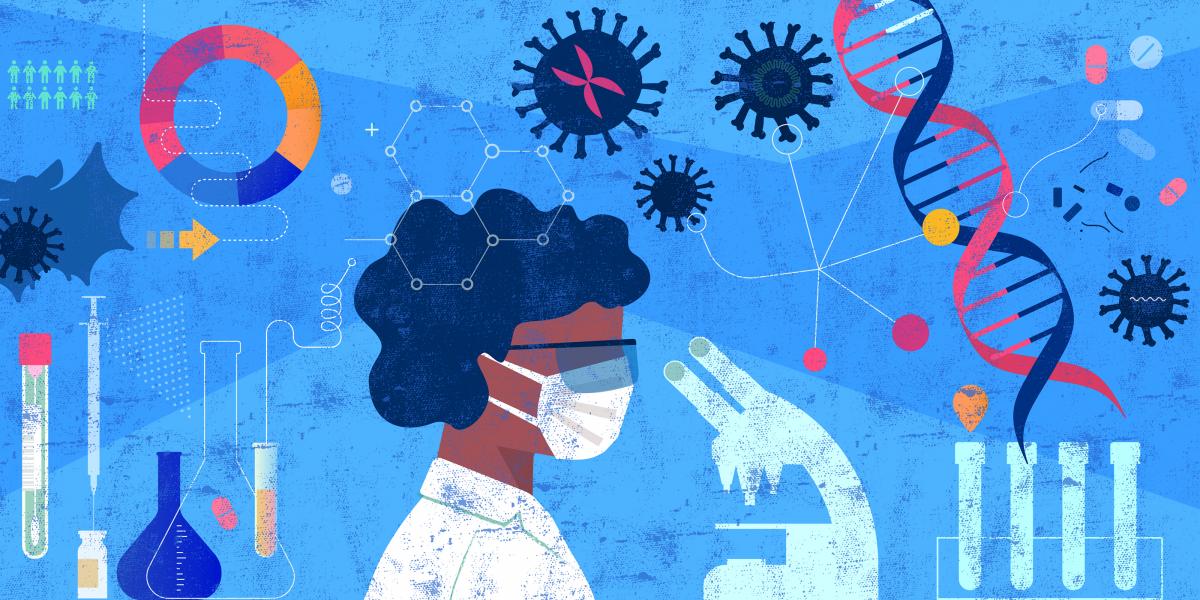Five Covid Lessons for Public Health
The pandemic exposed shortcomings in efforts to secure our collective health. Here’s how to get things back on track.
“I can’t wait for things to get back to normal.”
I’ve heard a variation of this thought many times in the last 18 months. The pandemic inflicted incalculable pain on so many people. I understand the sentiment, but I disagree—at least when it comes to public health.
We can’t let things get back to normal. Normal wasn’t good enough. Normal didn’t stop the coronavirus before it could spread worldwide and claim so many lives. Going back to the way things were isn’t an option. We must move forward and strive to do better.
The best future is one built on lessons gained from the past. And COVID-19 has left us with many harsh lessons.
Here are just five of the lessons that emerged from critical conversations with my colleagues at the Bloomberg School.
Good science isn’t good enough. We learned the hard way that proven medical and nonmedical interventions will not help control a pandemic if governments and communities are reluctant to follow the science. Even now, our society is fighting over masks and vaccines. We need to engage with politics—not flee from it. We must foster closer partnerships among scientists who develop the vaccines and medicines, social scientists, and marketing and communications experts adept at motivating the public to make use of best practices and lifesaving technologies. Public health professionals must work hand in hand with policymakers to communicate science in a way that is digestible and instills trust in decision-making. As one colleague put it, we have learned yet again that “public health is a team sport.”
Get to the source of health inequities. We have always known that disparities in housing, education, employment, and other social drivers produce inequities in health, but the pandemic cast a bright spotlight on this reality. We have seen yet again how unevenly the best health outcomes are spread across races and ethnicities and between the haves and have nots. One reason why the U.S. suffered disproportionately in the pandemic compared to other wealthy nations is that we were unwell to begin with. We need to address this deficit by investing in primary prevention and recognizing the outsized role of social drivers in a population’s health and well-being. As Sir Michael Marmot aptly put it, “Health inequalities and the social determinants of health are not a footnote to the determinants of health. They are the main issue.” If we are to advance health in this country, we must advance equity and social justice.
The urgency of the pandemic forced us to learn—quickly—what works and what doesn’t work. We need to carry these lessons forward and do even better next time.
National perspectives are too limited. The pandemic reminded us more than ever before that our health as a nation is inexorably interconnected with our global environment. A virus that emerges in one country can quickly spread to all four corners of the world. We share common vulnerabilities across borders—north-south and east-west. Unprecedented global cooperation—not nationalism nor isolationism—will be critical for a healthy future. We must work together to share data, build a global early warning system, and develop common, evidence-driven polices to protect all interests. And lest there be any doubt, sharing vaccines with the world is not only the right thing to do, it is critical to our national interest.
Better data and surveillance are needed now. The pandemic exposed weaknesses in our public health infrastructure. We knew what to do, but we failed because we did not have the resources in place to ramp up quickly. Critical to that infrastructure is access to accurate, real-time data and coordinated surveillance. Artificial intelligence–based surveillance systems, genomic sequencing done at the local level, and robust case identification, diagnostics, and contact tracing capacity must be quickly developed and sustained. This pandemic also taught us that we must accept uncertainty and be prepared. The virus changed quickly in ways that are difficult for models to predict precisely. So, we must invest in epidemiological intelligence that can pivot to incorporate new and timely data.
Biomedical science is key. We have witnessed the speed at which science can move—in part because we had been investing in the technologies that provided a platform upon which to develop a vaccine of unprecedented effectiveness in record time. Progress was accelerated, however, through an infusion of resources and the creation of extraordinary collaborations across the public and private sectors as well as national boundaries. The urgency of the pandemic forced us to learn—quickly—what works and what doesn’t work. We need to carry these lessons forward and do even better next time. The biomedical research establishment is key to protecting society against a pandemic, and it requires our ongoing and substantive investment.
We have learned that we need to change the way we do things. We may not be able to act on these lessons overnight, but we do need to move with urgency and sustained support because emerging infectious diseases will continue to threaten us.
We must act boldly to deliver on the opportunities before us.
